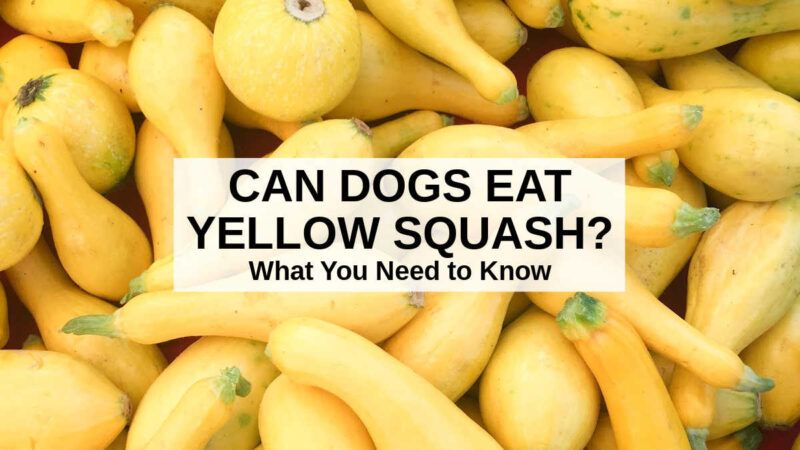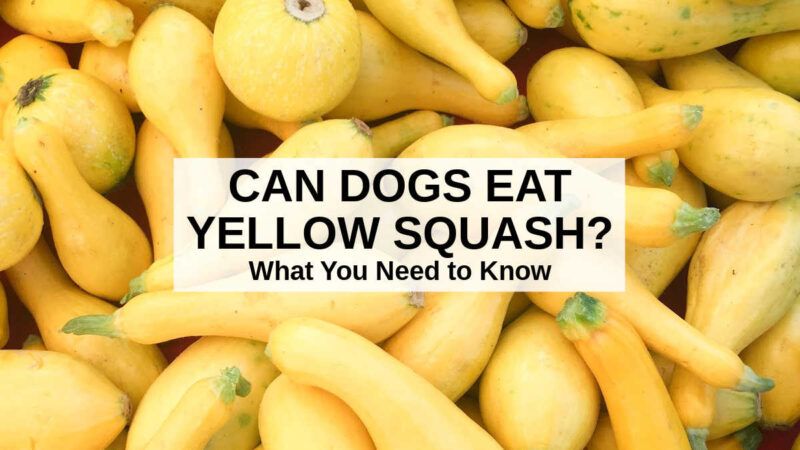Introduction
Yellow squash is a nutritious summer vegetable that belongs to the gourd family, which also includes zucchini, cucumber, and pumpkin. It has a tender texture and mild, sweet flavor, making it a versatile ingredient for many dishes. Yellow squash comes in several varieties including straightneck, crookneck, pattypan, and cousa squash. Its bright yellow to orange flesh is rich in beneficial vitamins, minerals, and antioxidants.
Some of the key nutrients found in yellow squash include vitamin C, vitamin A, manganese, magnesium, potassium, riboflavin, and folate. It is low in calories, with only 20 calories in 1 cup. The high water and fiber content of yellow squash also make it hydrating and filling. With its stellar nutritional profile and health benefits, yellow squash can be a nutritious addition to a dog’s diet.
Is Yellow Squash Safe For Dogs?
Yes, yellow squash is generally safe for dogs to eat in moderation (Summer Squash Is Not Toxic To Dogs, 2022). Yellow squash belongs to the summer squash family and has a mild flavor and soft flesh that most dogs enjoy. The flesh contains beta-carotene, vitamins, and minerals that can benefit your dog’s health.

Both raw and cooked yellow squash are safe options for dogs, as long as you remove the seeds and rind first. The seeds could potentially cause intestinal blockage or upset stomach in dogs. The rind is also tough and difficult for dogs to digest (Can Dogs Eat Yellow Squash? Benefits and Precautions, 2023).
It’s best to introduce yellow squash slowly and watch for any signs of digestive upset. Provided your dog tolerates it well, yellow squash can be a nutritious snack or addition to their diet in moderation. Overall, yellow squash is non-toxic and safe for dogs when prepared properly.
Nutritional Value
Yellow squash is highly nutritious for dogs. It is high in vitamins A and C, as well as magnesium. According to Can Dogs Eat Squash? – AKC, yellow squash contains vitamin A, a powerful antioxidant that protects cells from damage. It is also rich in vitamin C, which helps repair tissues in a dog’s body. Additionally, yellow squash contains magnesium, which is important for bone development and enzyme functioning.

The high vitamin and mineral content make yellow squash a healthy treat for dogs. The vitamins support immune health, while the magnesium aids bone growth. The antioxidants in the squash also promote overall wellbeing in canines.
Benefits
Yellow squash provides many health benefits for dogs. It is rich in vitamin A, which supports eye health, immune function, skin, and coat (source). Vitamin A helps maintain healthy skin and mucus membranes, protecting against infections. The vitamin C in yellow squash also supports immune health and is an antioxidant that fights cell damage (source).

The fiber and water content in yellow squash supports digestive health. Fiber regulates digestion and prevents constipation. The high water content also helps keep dogs hydrated and promotes regular bowel movements. Overall, yellow squash is a nutritious vegetable that provides vitamins, minerals, and fiber that benefit canine health.
Precautions
Yellow squash is generally safe for dogs to eat in moderation. However, there are some precautions to be aware of:
Eating too much raw yellow squash can lead to gastrointestinal upset like vomiting, diarrhea, and abdominal pain. This is due to the high fiber and water content which can be hard for some dogs to digest (Source). It’s best to introduce yellow squash gradually and feed small amounts at first.
The skin and seeds of yellow squash contain cucurbitacins which can potentially cause stomach irritation in dogs. It’s recommended to peel the skin and remove the seeds before feeding yellow squash to dogs (Source).
Some dogs may be allergic to squash. Look for symptoms like itching, hives, swelling, and diarrhea after eating squash. Discontinue feeding if an allergy is suspected.
Serving Size
When first introducing yellow squash to your dog’s diet, it’s important to start with small amounts. This allows you to monitor your dog for any adverse reactions or digestive upset. Begin by only feeding your dog a spoonful or two of cooked, cubed yellow squash alongside their regular food.
Gradually increase the amount over a period of several days or weeks, up to around 1⁄4 to 1⁄2 cup per day for a medium-sized dog. Always start slow when introducing new foods. Pay attention to stool consistency and any vomiting or diarrhea, which could indicate an intolerance.
The exact serving size can vary based on your dog’s size and tolerance. Very small dogs may only handle a teaspoon initially, while large breeds can likely start with a few tablespoons. Monitor portions and scale up slowly while looking for signs of digestive upset.
In general, yellow squash should only make up a small portion of your dog’s overall diet. It’s best fed as an occasional treat or as part of a balanced home-cooked meal, not a dietary staple.
Preparation
When preparing yellow squash for dogs, it’s important to remove the seeds and skin first. The skin can be tough for dogs to digest. The seeds also contain compounds that could potentially be toxic to dogs in large quantities.

According to Pet-How.com, the best way to prepare yellow squash for dogs is to steam it first to soften it and make it easier to digest (source). Steaming helps preserve the vegetable’s nutritional value while still cooking it enough for your dog.
Cut the squash into small, bite-sized pieces after seeding and peeling. Steam until just soft enough for your dog to chew and swallow easily. Let cool before serving.
Avoid raw yellow squash, as the tough skin and seeds could lead to gastrointestinal upset. Always cook yellow squash thoroughly before feeding it to dogs.
Alternatives
Though yellow squash can be a healthy treat for dogs in moderation, some pet owners may prefer to offer alternative vegetable options. Two popular alternatives to yellow squash for dogs include:
Carrots – Carrots are crunchy, sweet, and rich in vitamins A, K, and C. They are a great low-calorie snack that can promote eye and dental health in dogs. Carrots should be washed, peeled, and cut into bite-sized pieces before serving to dogs raw or cooked. According to toegrips.com, carrots are one of the top vegetables dogs love.
Green Beans – Green beans provide dogs with vitamin C, vitamin K, manganese, and fiber. They make for a satisfying crunchy snack when served raw. Green beans can also be lightly steamed or boiled for a softer texture. They are low in calories, making them a good choice for dogs needing to lose weight. According to rawbistro.com, green beans are one of the top 10 dog-friendly vegetables.
Dog-Friendly Squash Recipes
Squash can make a nutritious addition to any dog’s diet. Here are some tasty recipe ideas for incorporating yellow squash into homemade dog food:
-
Squash and Chicken Dog Food – Cook chicken breasts and yellow squash together. Mix in some cooked brown rice and spinach. Top with a spoonful of plain yogurt.
-
Squash Puppy Treats – Mash some cooked yellow squash with peanut butter and whole wheat flour. Roll into small bite-sized treats and bake until firm.
-
Squash and Sweet Potato Casserole – Layer cooked yellow squash, sweet potato, chicken, and cheese in a baking dish. Sprinkle with bread crumbs and bake.
-
Pumpkin Squash Dog Ice Cream – Blend cooked squash with canned pumpkin, plain yogurt, and honey. Pour into ice cube trays and freeze.
Get creative with yellow squash! It can be a healthy, tasty addition to your dog’s homemade meals and snacks.
Conclusion
Yellow squash can be a healthy, nutritious treat in moderation. It provides many vitamins, minerals, and beneficial plant compounds that may boost immune function, support bone health, and slow aging. However, it’s important not to overdo it. Too much squash can lead to gastrointestinal upset. Start with small portions and monitor your dog’s reaction.
When introducing any new food, go slowly at first. Squash should only make up a small part of your dog’s overall diet. For most dogs, a few bites 1-2 times per week is plenty. Purchase fresh squash when possible and avoid seasoning, as salt and spices can cause issues. Cook the squash thoroughly until soft, then serve it plain or mixed into their regular dog food.
With proper precautions, yellow squash can be a tasty way to add nutrition variety to your dog’s meals. Just be sure to consult your veterinarian if you have any concerns. Overall, squash is typically safe for dogs to eat and can provide a beneficial supplemental source of vitamins, minerals, and antioxidants when fed in moderation.
